Meat for your pet. Help! My dog is getting so thin. A broadcast of “Radar“, fresh meat is full of thyroid hormones because thyroid waste is added. Every dog owner should actually see this. I was shocked. But it is not the first time that dog owners are startled. A nice starting point to get some better insights, in what is good and what is wrong for your dog, is the blog of Skeptvet. This page is meant to cook responsibly for your dog.
Table of Contents
Do it yourself
Occasionally we get a fresh rumen from the butcher. Then you get a larynx, an esophagus, a rumen and a reticulum that is turned inside out and cleaned (in our case). The larynx is dangerous and immediately enters the waste bin. The esophagus is chopped into rings and enters the pan. They get flipped, because it is a real treat! Linguistically, it is not right to refer to the reticulum as rumen. But for convenience it is so easy. The rumen goes into strips through a large meat grinder. There is always some residual sand in it, so the mill does wear. After that, the rumen is boiled, cooled down quickly and eventually everything goes into the freezer in small portions. A large rumen yields almost 20 kg.
I notice that the stools of our dogs are better on the basis of fewer kibble, supplemented with rumen. The kibble remain the main part because we assume that this is a good basis. If your dog’s farts smell like rotten eggs, then that is H2S gas. That is due to the breakdown of proteins and you might consider adding less meat.
Slaughter waste
The point is that this is offal. No attention is paid to it, sometimes it is cooled, sometimes not, it is collected and disappears in the animal food chain. I pick up the rumen immediately after slaughter, that is the agreement with the butcher. If you do not process the rumen immediately, the maggots quickly run around. Good enough for the “kibble makers” and “fresh meat manufacturers” is my suspicion – scandals are enough to be found in the media. There is also another side, we think from an emotion, find things dirty that a dog does not, such as eating faeces and chewing on cadavers that are found in nature.
Dogs – like humans – do not have to become ill from uncooked meat, but it is a little naive, you do not give your children raw meat, especially if that is “over the date”. A nice pampering with a freezer pack “Fresh meat” from the supermarket “because it is so healthy” is a questionable reasoning. Exposing your dog to unnecessary risks can be prevented by cooking and freezing. In addition, I use the best imaginable meat. However, and as an example, I have also encountered flukes in freshly slaughtered meat (presumably “Calicophoron daubneyi” and or “Paramphistomum leydeni”, see for example https://www.sciencedirect.com/science/article/pii/S0304401717302650 ). Not so nice to face the peristaltic movements and convincing perfectly to cook. If I give them a fresh heart, are there no eggs of worms in it? So I cook that too – the golden rule is cooking. Worming is something we do four times a year, with different active substances. However, prevention is better than curing.
A follow-up question is whether the kibble manufacturers also add thyroid? I would not be surprised, cut up, so that the dosage is limited, but above all, do not throw anything away.
Holders of dogs are cramped in terms of choice of dog food. Fresh meat, cooked and kibble have a questionable reputation when it comes to quality. There is a lot of fiddling in the industry with ingredients that should not actually end up in the chain. However, that is often (not always!) a reasoning from emotion and not from common sense. Doing it yourself is mainly pleasing your four-legged friends.
Some considerations
Jack: “What does his coat look nice and shiny, I can see that it is a healthy dog.” Jill: “My dog has terminal cancer.” Morality: Be critical and always use your logical sense.
What can you do yourself, as an alternative, to ensure that your dog gets what it needs? It requires expertise and with this page I would like to provide some clarification and information. However, for me it is also a search in unknown territory. In addition, a puppy has different needs, it is different for each breed, seniors have different needs.
For our dogs it is supplementary food, kibble are the basis. The dogs are adults, not puppies.
And then another tip, do not go to Facebook for information because then you know for sure that you are misinformed. If you want to know how disturbed some people are, then of course you have to do that.
Points that are important:
- The balance of proteins, carbohydrates and fats for energy needs.
- Correct provision of trace elements and vitamins for the system.
- Feeding a lot of meat also means extra pressure on the kidneys because a lot of purine has to be processed.
- Do not go beyond upper limits of undesirable substances that endanger health.
The kitchen
The kitchen requires some preparation.
- You need a big pan, 20 litres is not a luxury for a rumen.
- A chopper makes work easier, just like a sturdy wallpaper or fabric scissors. A large cutting board that does not easily slide in all directions. Knives and scissors should be razor-sharp.
- Consider wearing a protective glove when cutting.
- Put on nitril disposable gloves and disinfect your hands well afterwards.
- To keep everything clean – both before and afterwards – you can disinfect with, for example, an 80% alcohol solution. Bioethanol with a minimum of 20% and a maximum of 30% water in the smallest possible plant spray (~ 0.5 l) is sufficient. Do not store in the kitchen, wait a minute after spraying, then wipe it away and let everything evaporate. Do not disinfect when you are cooking because of the fire hazard, stay alert!
- A meat grinder: For little money you can buy heavy models. Make sure rumen is as clean as possible so that residual sand does not dull the cutters.
- After cooking you must ensure that everything cools down quickly. Especially the temperature range around 20 – 40 degrees Celsius is dangerous because of bacterial growth. If you packed it in plastic bags, you can cool them in a container of water. If you use trays then it needs to be air-cooled. So you have to look for a cool place for this.
- It is possible that your freezer does not like it when 20 kg is frozen in one go. That is also a point to take into account.
- Clean everything afterwards and disinfect everything.
The menu card
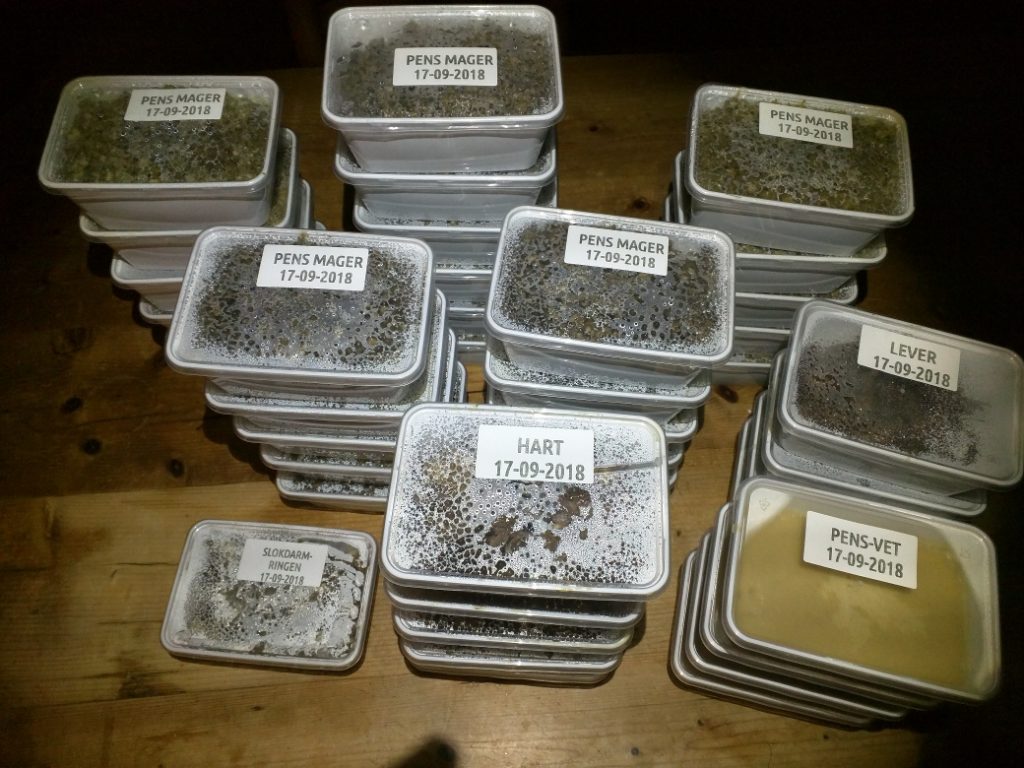
On the photo you get an idea of quantities. Each bin is one litre. This is the yield after preparation of two rumens, a heart and a half liver. Approximately 1.5 litres of fat is released per rumen, after skimming. This fat is used for the cooking of the esophagus rings, the heart and the liver. The source is double muscled cattle. To make this you stand in the kitchen for a couple of hours.
Because this meat is processed immediately after slaughter, this also means that parasites such as worms are not frozen to death – many other organisms survive the freezer, but that aside.
Never give this meat raw!
Hereafter we talk about baking but with a large amount of rumen fat it is better to talk about cooking.
Esophagus is delicacy
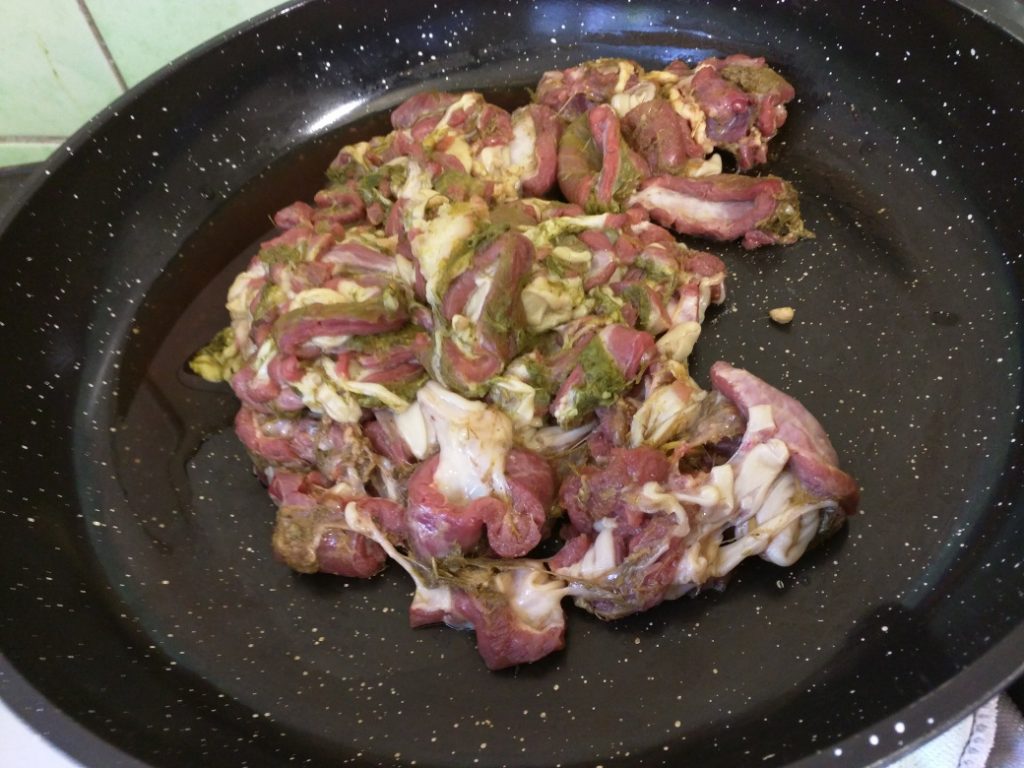
The esophagus is between the larynx and the rumen. Cut off the larynx and throw it away, do not give it to your dog! Cut the esophagus from the rumen. Then chop the esophagus into rings. If you have fat from the rumen, cook the rings in it. Use the rings to reward, they are really crazy about it.
Rumen
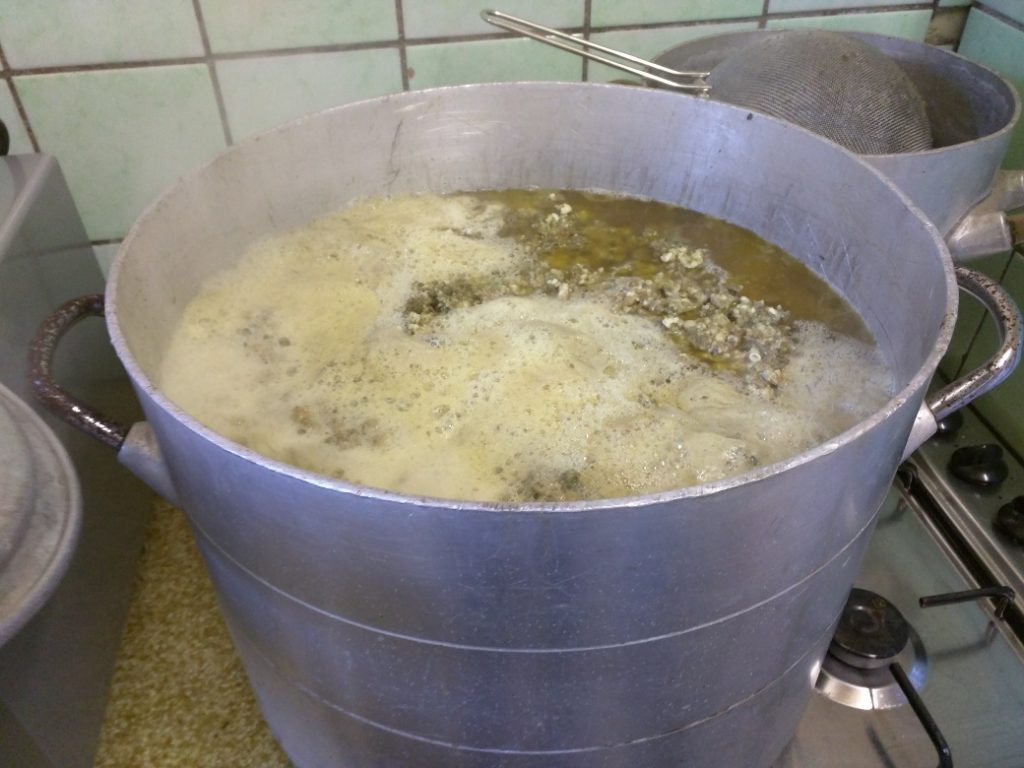
The rumen of one beef cow with one litre of water: the total is a fraction below the 20 litre mark. This is almost industrial cooking.
Minced rumen meat
Who prepares tripe for human consumption has a long way to go but for the dogs we are finished quicker. The butcher will have emptied the rumen and hopefully sprayed with water. It is not possible to remove all grass residue and sand, rinse away what is easy to release. A large sink is a luxury but above a pit, in a place where no dogs come, is also an idea.
You can cut long strips for the grinder with a large and sharp cut knife. You can cut difficult pieces with heavy shears. A part of the meat has a net, honeycomb structure, that is the reticulum that goes into bars in the same way. You have to figure out how wide you can make the bars without getting the mill into trouble.
While you are cutting, the mill is on and you enter the bars. You can place a large plastic container under the mill. It can sometimes spatter and that is not pleasant for yourself and your kitchen. A nozzle or a piece of cloth for the cutting plate prevents this.
In the meantime, you can set up a big pan with a litre of water, and add the minced rumen meat. When everything is grinded, let the pan with a lid cook well. You probably want to ventilate but the smell also attracts flies. The smell is a bit weird but if the rumen is reasonably clean it also smells less.
When you are done with cooking, you can consider skimming fat – or not. A bit for the esophagus rings perhaps?
Then you do everything in trays – those of the Chinese restaurants are very nice. Remove from the bottom of the pan and distribute. Allow the containers with lids to cool down, for example outside with some space between the trays. When they have cooled sufficiently, they can be placed in the freezer.
Rumen fat
A dilemma arises with rumen fat. On the one hand, we do not want to throw anything away. On the other hand, “rumen fat” is a hard fat, so it is full of saturated fats and is not the healthiest source of energy. The taste of what you cook in rumen fat is excellent so we do that. But in the end there is about 1.5 litres of fat per rumen and that does not go to the dog. This also underpins the reasoning to skim the fat.
Liver
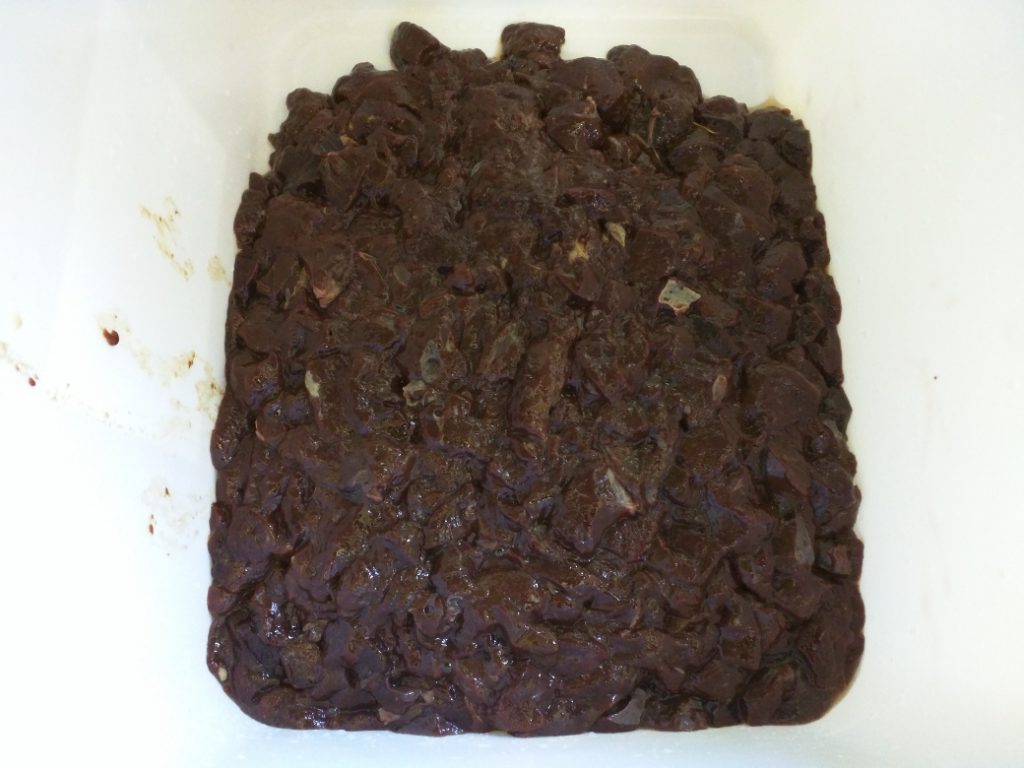
Liver contains a lot of vitamin A. Liver laxates at an upper value. Liver contains a lot of purine. How much liver can you give your dog? Safe margin: 0.25 grams per kilo of dog per day. There are several data, but 20 grams of boiled liver for humans covers the total daily requirement for vitamin A (~ 800 μg) and therefore the kidney load by purine is also not a problem. So beware with too much liver. Cut the liver into smaller pieces that are easy to dose.
You can chop a small part and cook it with the rumen. You will then have to think in advance how much rumen you give and adjust the amount of liver accordingly.
An interesting link is here: https://thecaninechefcookbook.com/blog/can-dogs-eat-beef-kidneys
Heart
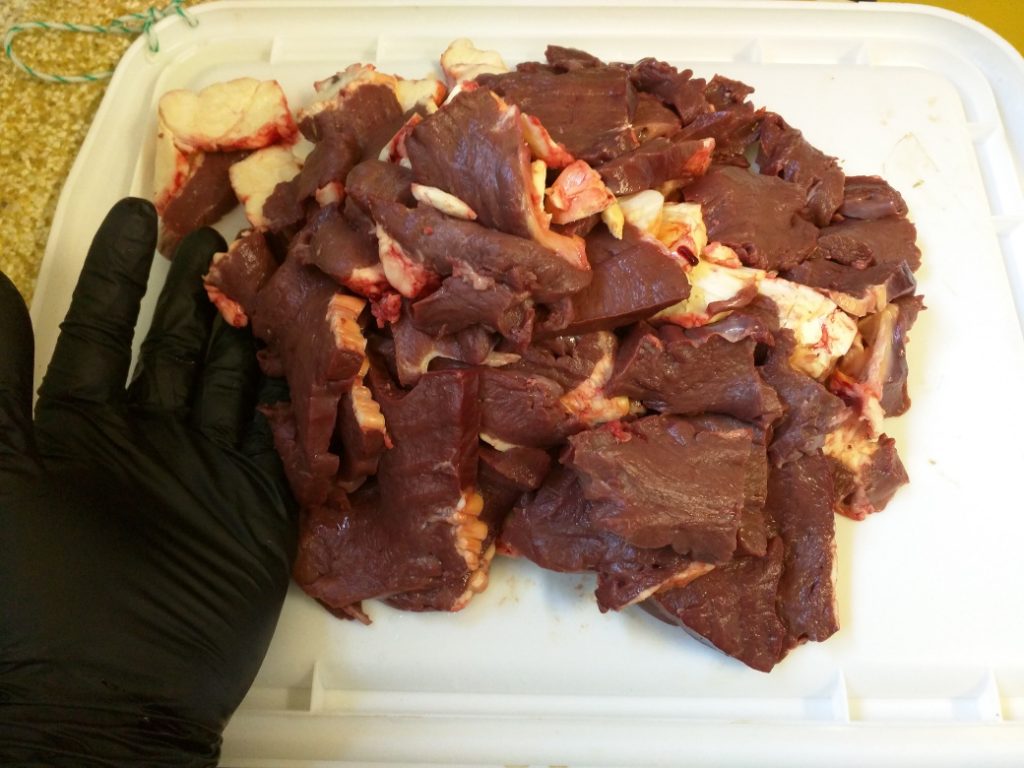
You can make minced meat from it and boil it with the rumen, but heart invites you to cut small slices like on the image and then bake or cook it – in rumen fat. Alternatively, you can make minced meat and make meatballs with some egg.
Dogs can get diarrhoea from a lot of heart, so also limit feeding here.